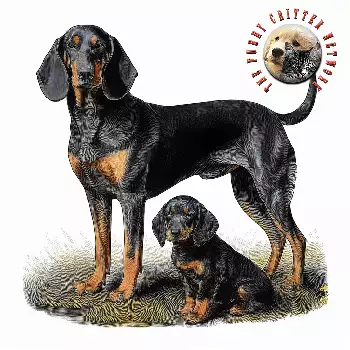The Smalandsstovare is generally considered a healthy, hardy breed with few major genetic health issues. This robust health is partly attributable to the breed's rarity and careful management by dedicated breeders who have worked to maintain genetic diversity. Between 1994 and 2008, the Swedish breed club commissioned comprehensive genetic testing on numerous dogs, which revealed no specific health issues unique to the breed nor any major common genetic problems. This gives the Smalandsstovare an advantage over many more popular breeds that struggle with inherited health conditions.
Despite their overall excellent health, prospective owners should be aware of conditions that can affect the breed, even if they occur infrequently. Hip dysplasia, a malformation of the hip joint that can cause pain and lameness, has been documented in the breed, though at lower rates than in many other medium-sized dogs. Responsible breeders screen their breeding stock through radiographic evaluation and only breed dogs with good hip scores to minimize the risk of producing affected puppies. Elbow dysplasia, a similar developmental problem affecting the elbow joint, can also occur but is quite rare in the breed.
Progressive retinal atrophy, an inherited degenerative eye disease that eventually leads to blindness, has been identified in some Smalandsstovare lines. This condition typically manifests first as night blindness, with affected dogs showing reluctance to navigate in dim lighting. As the disease progresses, daytime vision deteriorates as well. Genetic testing is available to identify carriers of PRA mutations, allowing breeders to make informed decisions about which dogs to breed. Responsible breeders test their stock and avoid breeding combinations that could produce affected puppies.
Epilepsy, a neurological disorder causing seizures, has been reported occasionally in the breed. These seizures can range from brief, mild episodes to more severe convulsions. While epilepsy can often be managed with medication, it requires lifelong treatment and monitoring. The genetic component of epilepsy in dogs is complex and not fully understood, making it difficult to screen for and eliminate from breeding programs.
Hypothyroidism, an endocrine disorder where the thyroid gland produces insufficient hormones, can affect Smalandsstovare. Symptoms include weight gain, lethargy, skin problems, and coat changes. This condition is relatively easy to diagnose through blood testing and can be effectively managed with daily thyroid hormone supplementation. Regular monitoring ensures the medication dosage remains appropriate.
Regular veterinary care forms the foundation of maintaining a Smalandsstovare's health throughout their life. Annual wellness examinations allow veterinarians to detect emerging problems early when they are most treatable. These visits should include thorough physical examinations, discussion of any behavioral or health changes noticed at home, and updating vaccinations according to the veterinarian's recommendations based on the dog's lifestyle and local disease risks.
Parasite prevention is essential for maintaining optimal health. Monthly heartworm preventative medication protects against this potentially fatal parasitic infection transmitted by mosquitoes. Many heartworm preventatives also protect against intestinal parasites. Regular fecal examinations help ensure the dog remains free of intestinal worms. Flea and tick prevention is important both for the dog's comfort and to prevent transmission of tick-borne diseases like Lyme disease.
Dental care throughout the dog's life helps prevent periodontal disease and the systemic health problems it can cause. Professional dental cleanings by a veterinarian, combined with home dental care, keep teeth and gums healthy. The average lifespan of a Smalandsstovare is twelve to fifteen years, with many individuals remaining active and healthy well into their senior years. Providing appropriate nutrition, maintaining a healthy weight through proper diet and exercise, and ensuring regular preventive veterinary care gives each dog the best chance of reaching or exceeding the upper end of this lifespan range.
Common Health Issues
- Hip dysplasia, a malformation of the hip joint that can cause pain and lameness, has been documented in the breed, though at lower rates than in many other medium-sized dogs.
- Epilepsy, a neurological disorder causing seizures, has been reported occasionally in the breed.
- While epilepsy can often be managed with medication, it requires lifelong treatment and monitoring.
- The genetic component of epilepsy in dogs is complex and not fully understood, making it difficult to screen for and eliminate from breeding programs.
- Hypothyroidism, an endocrine disorder where the thyroid gland produces insufficient hormones, can affect Smalandsstovare.
Preventive Care & Health Monitoring
- Regular veterinary care forms the foundation of maintaining a Smalandsstovare's health throughout their life.
- These visits should include thorough physical examinations, discussion of any behavioral or health changes noticed at home, and updating vaccinations according to the veterinarian's recommendations based on the dog's lifestyle and local disease risks.
- Parasite prevention is essential for maintaining optimal health.
- Dental care throughout the dog's life helps prevent periodontal disease and the systemic health problems it can cause.
Regular veterinary check-ups and preventive care are essential for maintaining your Chien Courant Smaland's health and longevity.

